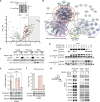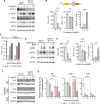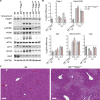Hepatovirus translation requires PDGFA-associated protein 1, an eIF4E-binding protein regulating endoplasmic reticulum stress responses
- PMID: 39565848
- PMCID: PMC11578187
- DOI: 10.1126/sciadv.adq6342
Hepatovirus translation requires PDGFA-associated protein 1, an eIF4E-binding protein regulating endoplasmic reticulum stress responses
Abstract
The overexpression and misfolding of viral proteins in the endoplasmic reticulum (ER) may cause cellular stress, thereby inducing a cytoprotective, proteostatic host response involving phosphorylation of eukaryotic translation initiation factor 2 subunit alpha (eIF2α). Here, we show that hepatitis A virus, a positive-strand RNA virus responsible for infectious hepatitis, adopts a stress-resistant, eIF2α-independent mechanism of translation to ensure the synthesis of viral proteins within the infected liver. Cap-independent translation directed by the hepatovirus internal ribosome entry site and productive hepatovirus infection of mice both require platelet-derived growth factor subunit A (PDGFA)-associated protein 1 (PDAP1), a small phosphoprotein of unknown function with eIF4E-binding activity. PDAP1 also interacts with eIF1A and is essential for translating stress-resistant host messenger RNAs that evade the proteostatic response to ER stress and that encode proteins promoting the survival of stressed cells.
Figures






References
-
- S. M. Lemon, in Fields Virology: RNA Viruses, P. M. Howley, D. M. Knipe, Eds. (Wolters Kluwer, ed. 7, 2022), pp. 22–58.
MeSH terms
Substances
Grants and funding
LinkOut - more resources
Full Text Sources
Research Materials
Miscellaneous

